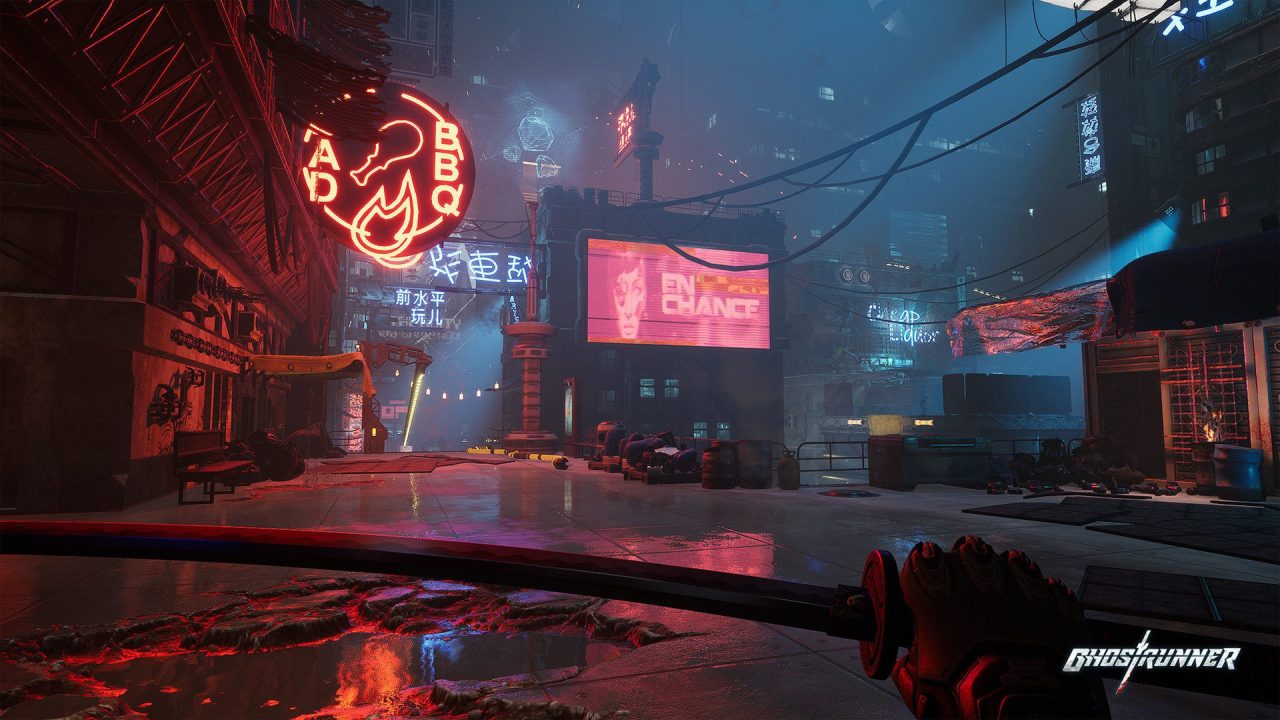A team effort between All In Games, 505 Studios, and 3D Realms, Ghostrunner is a first-person action game set in a cyberpunk dystopia, featuring cyborg ninjas and one-hit-death difficulty. If you feel like you’ve heard that before, you probably have, since cyberpunk seems to be 2020’s flavor. However, we’re not here to discuss the trend’s relevance, but to take a look at what Ghostrunner has to offer, good or bad.
Ghostrunner Dredd 2049: Legacy

The campaign takes place inside Dharma Tower, years after a non-descript cataclysm made it impossible to live outside. You take on the role of Jack, a ghostrunner that has been quite literally thrown from the top of the tower into the slums at the bottom. You wake up with amnesia, and Whisper, one of the 3 other main characters, contacts you and informs you of the event that happened since your fall. A corrupt leader named Mara staged a coup against Whisper, and took control of Dharma Tower, killing (almost) all ghostrunners and resistance members in the process. Her goons now rule over the different levels of the tower, and you must make your way up the tower to face her, with the help of Whisper (also known as The Architect) and Zoe, a resistance member. In the introduction, you learn that ghostrunners were technologically-augmented mercenaries employed to keep balance in Dharma Tower. Your augmentations, on top of making you an excellent warrior, allow you to access the cyberspace, a universe that exists in parallel to the actual world. That is where you’ll learn new abilities and skills, amongst other things. As per the title of this paragraph, you may guess this game took inspiration from certain cyberpunk franchises. Dharma Tower feels very similar to Peach Trees Tower from Dredd, especially since you must fight your way to the top before facing a crazed leader, armed with your signature weapon and stoic one-liners. The Cyberspace is reminiscent of the virtual world from Tron, existing in parallel with the real world but still having physical effects on it. The environment is similar to what’s found in the Bladerunner franchise; neon billboards reflecting in a puddle on a concrete rooftop. The inspirations are clear, and Ghostrunner does a good job of combining established cyberpunk/dystopian concepts into a unique experience. The story, while taking a back seat to let the gameplay shine, is well crafted and justifies the player’s cause. The effects of Mara’s rule are shown to the player with goons patrolling streets on lockdown, and told to the player by describing the chaos that ensued after Jack’s fall. Certain plot holes are intentionally created at points in the story, which the player character will point out, foreshadowing the somewhat obvious plot-twist. The game also succeeds in giving a constant sense of urgency, which compliments the state of constant movement present in the gameplay.
Nightmare difficulty? Cute.

Ghostrunner is a first person action game with platforming and puzzle elements, the parkour mechanic being what binds the whole thing together. The game features a one-hit death system. You’ll die from a single bullet, but your enemies will die in a single cut from your katana. To give you the edge in combat, your augmentations allow to to wall run, slide, and slow down time in midair to dodge projectiles. You also unlock abilities by interacting with Cyberspace terminals. Abilities such as a blast of energy to kill any enemy, and the possibility of turning enemies against each other. However, those powers are very circumstantial, and end up being used as crutches when an encounter is harder than expected. Every single engagement is different; different numbers of different enemies, obstacles, lines of sight, etc. In order to succeed in your encounters, you need to figure out the best possible run through the arena, carefully choosing in which order to kill which enemies, and which wall to run on. You may find the optimal run on the first try, or after a couple dozen deaths. Constant momentum will result in the most satisfying runs, but a slower approach may result in overall less deaths. Combat is a good 50% of the game, another 45% is occupied by platforming puzzles. Keeping speed and momentum while carefully choosing which wall to jump on, avoiding fire and electricity. Most of these puzzles are easy to figure out, and their difficulty lies in the execution. All in all, the combat and parkour result in a very challenging and equally rewarding gameplay. However, some levels and other mechanics end up hurting the playability, for both first and subsequent playthroughs. The early game tutorials do a poor job of explaining core mechanics, like the distance you can travel while slowed down, the range of your attacks, and how to correctly wall run. Those things are learned later on through experimentation, but poor tutorials on important mechanics result in a difficulty spike at the very start of the game. What hurts replayability are the Cyberspace puzzles which take up the remaining 5% of gameplay. No platforming, no killing, just 5-15 minute segments of optical illusion based puzzles. They are complex and unique, but in a game all about fast movement and perfect execution, slow puzzles with no immediate threats are alienating. Especially since puzzles are already present in the game, both in combat and platforming.
Perfect execution with flawed tools.

Die-and-retry is a well known concept in video games, usually present in more difficult games where death is expected. It allows the player to quickly chain runs of the same level over and over until the player masters it, usually through memorization of enemy layout and obstacles. Hotline Miami and Super Hot are two good examples of the implementation of die-and-retry. Ghostrunner also uses that mechanic, but it ends up being a mixed bag. Upon death, you’ll usually spawn right before the arena, behind some parkour obstacles. It allows to gain momentum before entering the arena again, and gives some time to reflect on the strategy, or perhaps even look around for a hidden way in. However, once in the arena, the tools at the player’s disposal, repetition and memorization, can fail and result in frustration. Some enemies can decide to not face the player, to not power their shield, or to move in a different pattern. It’s also possible for the parkour mechanic so simply not work, like a wall run not registering and the player falling to their death, or a sudden loss of speed for no reason, also resulting in death. Die-and-retry is based on a great number of variables always remaining the same and making the player adapt to them, learning each of them by heart through memorization. So when Ghostrunner occasionally messes with the variables, the whole formula is thrown out the window, and the game’s already extreme difficulty becomes nothing short of rigged against the player. Such glitches (if that’s what they are) are not common, and most levels are truly about memorizing the perfect path and sequence of enemies, but when variables do change, it definitely leaves a bad taste.
“I only rely on myself”

Ghostrunner is not a game for everyone. It is very challenging with an ending that borders on impossible, and the imperfect implementation of die-and-retry can become frustrating very quickly. Tutorials aren’t great, and those Cyberspace puzzles are out of place. But the high-octane combat and constant momentum combined with a simple story that feels unique yet not outlandish result in a refreshing game that bridges the gap between Doom Eternal and the upcoming Cyberpunk 2077.

